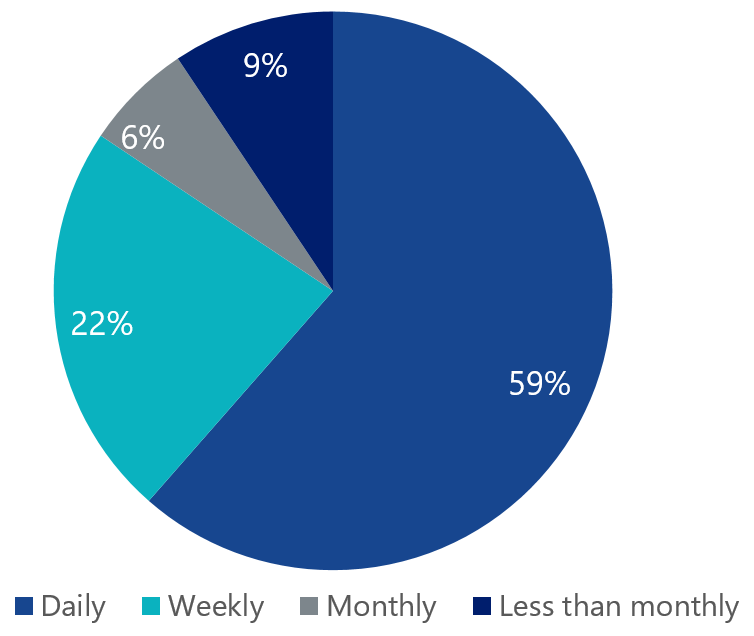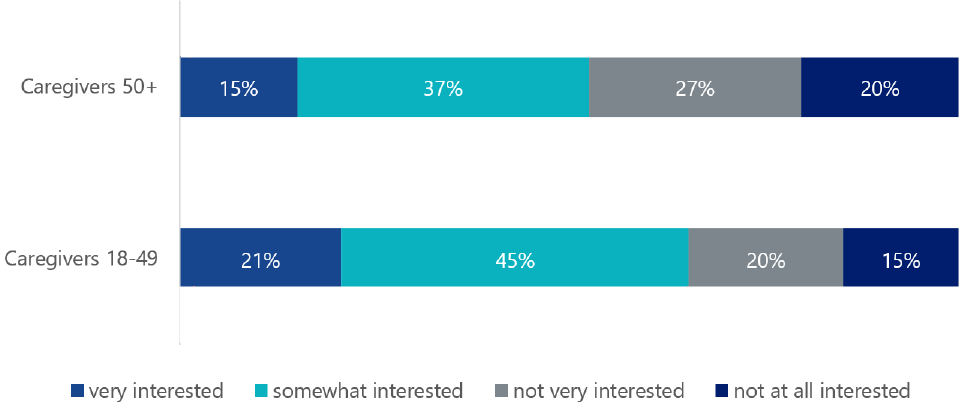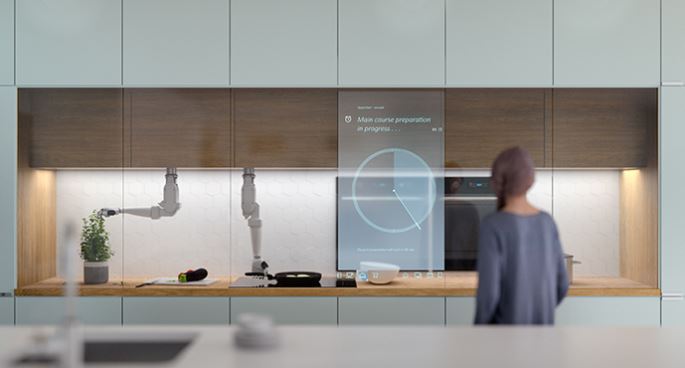Technology’s Role in Helping the Old to Cope at Home
11 May 2023
Share with a Friend
All fields required where indicated (*)Worldwide, people are living longer and populations are ageing in most countries1. Yet many of the elderly want to live an active, independent life for as long as possible. A suitable home can help, supporting their high quality of life.
Increasingly commercially-available smart-home devices are enabling people to age in their homes, while providing their caregivers (family and professionals) peace of mind that help is near should anything happen.
Smart Home Hubs Support Aging in Place
Aging-in-place technology doesn’t have to be complex. For example, movement sensors in combination with smart lighting can illuminate dark hallways and entryways. Smart plugs with timers can ensure that heaters or fans are turned on and off at appropriate times of day. And smart doorbells provide a feeling of safety by knowing who is at the door.
Smart home hubs, such as the Amazon Echo, Google Nest, or Samsung SmartThings, can connect the sensors mentioned above, helping elderly users to use voice commands to turn the lights on or off, but they can also assist to make a phone call, set reminders (e.g. to take medication), or play music or video. According to the 2023 AARP Tech Trends and Adults 50+ report2, one in three 50+ adults in the US now owns a home assistant and 60% of them use it daily.
Most 50+ Owners of Home Assistants Use Them Daily2
Frequency of using home assistants among those 50+ adults who own one (2022)

Moreover, these hubs also cater to ageing people and caregivers with specific services. Amazon, for instance, created the remote caregiving subscription service Alexa Together3 that – in addition to common Alexa services, such as reminders and calls – lets caregivers see activity feeds (e.g. when someone gets up and starts to interact with Alexa). In the case of an injury or fall, the resident can ask Alexa to call for help.
Smart phones and watches increasingly include features to support ageing in place. Smart watches from Apple and Samsung, for example, include an emergency button and accident detection. They also warn people about abnormal heart rates. The iPhone, meanwhile, can detect an unsteady gait that might later lead to a fall and warn increasing risk4.
More Companies Enter the Aging-in-Place Market
Caregivers and healthcare providers are increasingly aware of, and more open to, the use of smart home technology. AARP found in its 2023 survey2 that more than half of caregivers are very interested in using tech that helps them to perform their tasks. Healthcare providers, meanwhile, are using trials to test available technology that can give caregivers more peace of mind.
More Than Half of Caregivers Are Very Interested in Using Technology to Help With Caregiving Needs2
Interest in using technology to help with caregiving needs among those currently providing unpaid adult care by age range (2022)

In Canada, for example, a trial recently took place for people with dementia. Researchers created a test environment using commercially available equipment to create a monitoring service focused on caregivers. The study found that caregiving participants reported lower levels of anxiety and depression5.
The Canadian project was such a success that several participants asked to keep the equipment and a separate company – Esprit.ai – took over the installation of smart home systems, using the study’s setup. Esprit.ai is one of several companies that cater to the aging-in-place sub-group of smart home services. Their deep understanding of the needs of elderly people and the capabilities of technology enables them to create specific smart home setups.
Such a setup could include a pressure sensor that sends an alert when someone gets out of bed, connecting it to movement sensors to light up hallways to minimize the risk of stumbling. When someone is safely back in bed, the sensor tells the system to switch off the lights again.
Overcoming Adoption Barriers
However, many older people have trouble using the latest technology. AARP2 found that many of them find using today’s technology challenging due to complex designs, underlining the importance of making technology easy to use. Thankfully, elderly homeowners often get help from younger people (aka their (grand) children) when choosing and setting up smart home technology.
Despite this adoption barrier, smart home technology has a lot of potential to help people age comfortably. Homeowners, caregivers and smart home companies are all exploring the space, resulting in more solutions and services coming to the market.
Important Disclosure
This is a marketing communication. Please refer to the prospectus of the UCITS and to the KID before making any final investment decisions.
This information originates from Dasym Managed Accounts B.V. with registered address at Flevolaan 41 A, 1411 KC Naarden, the Netherlands (DMA), DMA is an investment company incorporated under Dutch law and regulated by the Dutch Authority for the Financial Markets (AFM) and the Dutch Central Bank (DNB). The information prepared by DMA is intended only to provide general and preliminary information to investors and shall not be construed as investment, legal or tax advice. The views and opinions expressed in this presentation are those of the author(s) but not necessarily those of DMA. DMA and its associated and affiliated companies (together “Dasym”) assume no liability with regards to any investment, divestment or retention decision taken by the investor on the basis of this information. Dasym makes no representation or warranty, express or implied, as to the accuracy or completeness of any of the information contained in this blog. Dasym undertakes no responsibility to update the information prepared by it and contained in this blog.
This information is published by VanEck (Europe) GmbH. VanEck (Europe) GmbH, with registered address at Kreuznacher Str. 30, 60486 Frankfurt, Germany, is a financial services provider regulated by the Federal Financial Supervisory Authority in Germany (BaFin). The information is intended only to provide general and preliminary information to investors and shall not be construed as investment, legal or tax advice. VanEck (Europe) GmbH and its associated and affiliated companies (together “VanEck”) assume no liability with regards to any investment, divestment or retention decision taken by the investor on the basis of this information. The views and opinions expressed are those of the author(s) but not necessarily those of VanEck. Opinions are current as of the publication date and are subject to change with market conditions. Certain statements contained herein may constitute projections, forecasts and other forward-looking statements, which do not reflect actual results. Information provided by third party sources is believed to be reliable and have not been independently verified for accuracy or completeness and cannot be guaranteed. VanEck assumes no liability for the content of any linked third-party site, and/or content hosted on external sites. Brokerage or transaction fees may apply.
VanEck Asset Management B.V., the management company of VanEck Smart Home Active UCITS ETF (the "ETF"), a sub-fund of VanEck UCITS ETFs plc, engaged Dasym Managed Accounts B.V., an investment company regulated by the Dutch Financial Service Supervisory Authority (AFM), as the investment advisor for the Fund. The Fund is registered with the Central Bank of Ireland and actively managed. Investing in the ETF should be interpreted as acquiring shares of the ETF and not the underlying assets.
Investors must read the sales prospectus and key investor information before investing in a fund. These are available in English and the KIIDs/KIDs in certain other languages as applicable and can be obtained free of charge at www.vaneck.com, from the Management Company or from the following local information agents:
UK - Facilities Agent: Computershare Investor Services PLC
Austria - Facility Agent: Erste Bank der oesterreichischen Sparkassen AG
Germany - Facility Agent: VanEck (Europe) GmbH
Spain - Facility Agent: VanEck (Europe) GmbH
Sweden - Paying Agent: Skandinaviska Enskilda Banken AB (publ)
France - Facility Agent: VanEck (Europe) GmbH
Portugal - Paying Agent: BEST – Banco Eletrónico de Serviço Total, S.A.
Luxembourg - Facility Agent: VanEck (Europe) GmbH
Performance quoted represents past performance. Current performance may be lower or higher than average annual returns shown. Discrete performance shows 12-month performance to the most recent quarter-end for each of the last 10 years where available. E.g. '1st year' shows the most recent of these 12-month periods and '2nd year' shows the previous 12 months period and so on.
Performance data for the Irish domiciled ETFs is displayed on a Net Asset Value basis, in Base Currency terms, with net income reinvested, net of fees. Returns may increase or decrease as a result of currency fluctuations.
All performance information is based on historical data and does not predict future returns. Investing is subject to risk, including the possible loss of principal.
No part of this material may be reproduced in any form, or referred to in any other publication, without express written permission of Dasym and VanEck.
© VanEck (Europe) GmbH / Dasym Managed Accounts B.V.
Sign-up for our ETF newsletter
Related Insights
Related Insights
12 March 2024
09 February 2024
16 January 2024
08 December 2023
